Simple Recessive Genetics
Again, we're going to start simple. One of the most common questions I've seen from beginners
is, "How many Albinos will I get if I breed an Albino to a normal?" The answer to this is
zero. Remember that recessive traits require both recessive genes to be present in order for
the trait to be apparent visually, but each parent will only pass one gene from the "Albino"
pool. That means your Albino only passes on one Albino gene to his offspring.
So let's do this example. Albino x Normal. The Albino can be represented by aa, while the normal
will be AA. (Remember, when discussing recessives, the lowercase letters represent the
recessive trait.) The Albino can pass on a or a, and the normal can pass on A or A. Do the
Punnett square the same way as before:
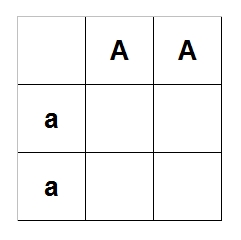
Now, fill in the chart:
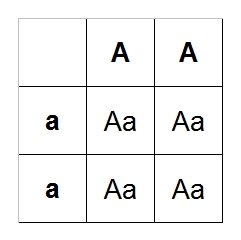
Notice that all the offspring are the same. No need to calculate percentages! All offspring
from this pairing will have one Albino gene and one normal gene. This is referred to as
heterozygous for the Albino gene, or "het" for short. These are all 100% hets; in other words,
we are 100% certain that the offspring carry the Albino gene.
As you may have guessed, not all hets are 100%. This is very important if you're interested
in working with recessive morphs. There are many unscrupulous sellers out there who try to use
people's unfamiliarity with genetics to rip them off with fake hets. (More on this later.)
Okay, back to genetics. We want to make Albinos, but we can't do that with an Albino and a normal.
How about two Albinos? So we're breeding aa x aa. Each snake can pass on a or a, like so:
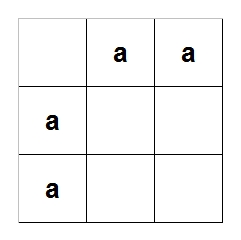
And then we fill it out....
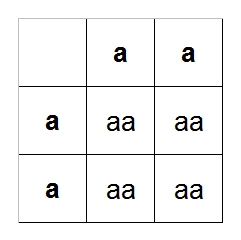
Hey, cool! We get all Albinos! Makes sense if you think about it: each parent passes on an Albino
gene, so all the offspring get two Albino genes, and we need two Albino genes for the trait to
be apparent. Woo!
But what if you don't want to buy or have the money to spend on two Albinos? What are our other choices?
Well, we have two more ways to make Albinos. Remember our 100% hets from earlier? We can cross
an Albino with a 100% het or two 100% hets together. (Note: from now on, if I say het Albino
or het other-recessive-trait, I'm referring to 100% hets. I will refer to non-100% hets by their
percentage possibility of being het. I'll also explain what I mean by that later.)
Let's start with Albino x het Albino: aa x Aa. The Albino can pass on a or a, and the het can
pass on A or a. Time for another Punnett square!
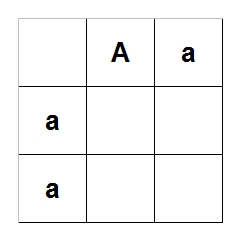
Fill it in....
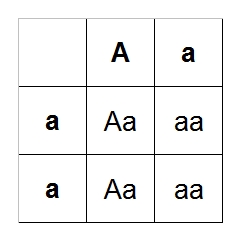
D'oh, time to do percentages again. We have 2/4 = 50% Albinos and 2/4 = 50% het Albinos. Each
egg has a 50% chance of being Albino or het Albino.
Are these 100% het Albinos? Yes! All the normal-looking offspring from this pairing have one
Albino gene. This means that if you cross a visual recessive with anything, all
the offspring will be, at minimum, 100% het for that recessive trait. Cool, huh?
Now let's try the other path: het Albino x het Albino. This is the cheapest way to produce any
visual recessive. Each parent will pass on A or a to their offspring:
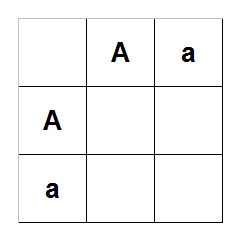
Fill it in, fill it in!
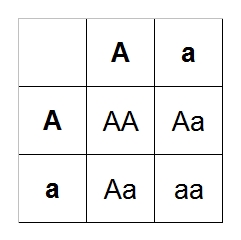
This is a little more complicated. One of four = 1/4 = 25% is a full Albino, two of the four =
2/4 = 50% are het Albino, and one of four = 1/4 = 25% are normals.
Think about this for a moment. The het Albinos look like normals--you can't tell the difference
between the hets from the normals! Then, how do we know which are the hets and which aren't?
You can't know for certain until you breed them! Well, crap! We don't want to wait that long
to sell the offspring! What do we do?
Let's just look at all the snakes that look normal. We have three that look normal but two are
actually het: 2/3 = 66% are het. Remember how we're always saying that the percentages of
offspring are for each egg? The same applies here. Each normal snake from this pairing has
a 66% chance of being het. This is how breeders label the snakes: 66% het Albino. So if you're
looking for hets and see one listed that is 66% het, you know why! This is a cheaper way of
making Albinos than the other methods mentioned so far because, since breeders can't guarantee
the snake is a het, non-100% het snakes sell for much less than 100% hets. The downside to going
this route is that you may be buying a normal...but you won't know it until you breed it. Still,
it's not a bad way to get into breeding, especially if you want low start-up costs: get an Albino
and at least two 66% hets, and you're bound to get some Albinos (unless you're really, really
unlucky).
There's one other combination we have not tried yet because it won't give you any Albinos:
het x normal, or Aa x AA:
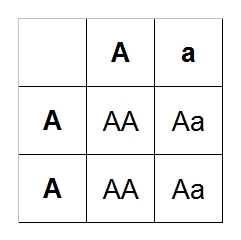
It looks like 2/4 = 50% are het Albino and 2/4 = 50% are normals. Again, since you can't tell the
difference between hets and normals, all the offspring will look normal. This means that when you
take into account all the offspring (all normals), 50% will be hets. These are referred to as
50% hets, and as you can probably guess, are even cheaper than 66% hets. In fact, most 50% hets
(except for the rare, super-expensive morphs) will be similar in price to normals. Again, the
tradeoff is that you only have a 50-50 chance of actually getting a het.
You may be wondering about crossing a 66% or 50% het with a normal. I could do those, but the math
gets really complicated really fast, and it's generally not a good idea to do crosses like this
unless you're okay with selling possible hets as normals. In fact, most breeders who do this
(usually while trying to get a complex mix of traits) will list the snakes as "possible hets"
without any percentages, and the good breeders will price these the same as normals.
A NOTE OF CAUTION!
When purchasing hets, you need to be absolutely certain the breeder you're purchasing them from is
honest. Because hets look like normals, it is very easy for unscrupulous people to rip off others
by selling normals as hets. The buyers won't know they've been ripped off until they try to
breed the snake, and for hatchlings, that could be two or three years down the road.
There's another thing to be aware of when purchasing hets. Even if you're dealing with a "trusted"
source, you still need to know where your hets are coming from. There are a lot of
people out there who deal with snakes like stocks: buy low, sell high. The not-so-nice term
for these people is "flippers"--they buy snakes from one person and turn around and sell them to
someone else (they "flip" the snakes). What's the problem with this? Well, say you're buying
a 100% het from a flipper. How do you know the person the flipper bought it from is
trustworthy? The headaches get even bigger when a snake has been flipped more than once.
Does Flipper #4 know where the snake was originally bred? Probably not! Your best bet
with hets is to buy directly from the breeder of the het. If asked, most breeders will send
pictures of the parents and/or pictures of the parents copulating to prove that the snake
they're selling is a real het. Again, it all boils down to whether the breeder is trustworthy,
as it's very easy to steal pictures on the Internet and claim them as your own....
Along the same lines, most breeders will offer "paperwork" with hets. This "paperwork" usually
shows a picture of the snake along with the parents and their genetics, signed by the breeder.
This is supposed to be a guarantee of the genetics of the het you're purchasing, and a lot of
people insist on receiving paperwork when buying hets. Personally, I find this trend to be rather
silly. These "proofs" of genetics are only as good as the paper they're printed on. Anyone
can take a normal, make up a bunch of stuff about fake parents and genetics, sign it, and send
it off with their normal-claimed-het snake. Again, the buyer won't know the snake is a normal
until a few years later when they breed it, and the scammer will be long gone by then.
The only time I think this type of paperwork could be useful is when a snake is flipped a few
times; if the paperwork continues to travel with the snake through several different buyers/sellers,
then it's much easier to track down who the original breeder was. Assuming the original breeder
isn't lying or a flipper made up his own paperwork...blah blah...etc. etc.
Like so many things, it's all about common sense and using your best judgment.
|






